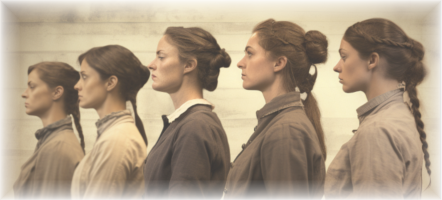Jess Hill began her biographies of convict women, ‘her girls’ as she called them, about 1970. At this time there was a growing interest in women’s rights and women’s history. Jess was a pioneer in the area of not only women’s history in general, but in convict biographical research in particular. While Jess was researching her girls, other women were engaged in similar research. Babette Smith was researching her convict ancestor Susannah Watson, which led to her researching all the convict women who arrived on the Princess Royal in 1829. Her research was published as A Cargo of Women in 1988. Portia Robinson’s study of colonial women, commenced in 1977, was published in 1988 as The Women of Botany Bay. Miriam Dixson’s research into the experiences of Australian women began in the late 1960s, and was published as The Real Matilda in 1976. Ann Summers’ Damned Whores & God’s Police was also published in 1976. More recently, Deborah Oxley published a chapter on Female Convicts in Convict Workers in 1988. She has since expanded that chapter into a book Convict Maids published in 1996.
Jess Hill and the Society of Australian Genealogists
The Society of Australian Genealogists was founded in 1932 to encourage and assist Australians in tracing their family history. At this time many researchers were more interested in finding their links with the ‘mother country’ than researching their colonial born antecedents. However, in the lead up to the bicentenaries of 1970 and 1988 interest in Australian genealogical research increased. This work is the result of research done by Miss Jess Hill during this period.
Jess Hill (1915-1995) joined the SAG in 1964, and, volunteered her time as a Library Assistant in the Australian Library for the following 28 years. Jess was appointed Assistant Honorary Research Secretary of the Society in 1975. In 1982 she was awarded the Society’s Certificate of Merit and was elected a Fellow of the Society in 1994. About 1970 Jess began to prepare biographies of all the convict women transported to Australia between 1788 and 1818. She initially put this data onto cards which she brought into the Society with her, using them as a reference tool to assist other researchers. Later she consolidated the information on the cards into brief biographies of each woman. These were then typed onto A3 sheets.
All the material contributed by Jess was donated for the benefit of the Society and its members and Jess never looked for personal recognition or financial compensation. In addition to this work she also placed with the Society her unpublished Miscellaneous Musters and Lists up to 1805, Miscellaneous Shipping for the years 1832, 1836, 1837, and the Norfolk Island Victualling Book 1792-1796. Examples of Jess’ research notes and working papers have been lodged in the Society of Australian Genealogist’s Primary Records Collection at 4/17068 and 4/17084.
Jess Hill’s failing health in later life did not allow her to complete the work. The main series of biographies remains as she had prepared it. Appendix A, the Supplementary List of Biographies, was prepared by Mrs Jill Roy from the pencilled notes which had been included on the main series and miscellaneous pieces of paper filed with this work. It was not always easy to determine exactly what was intended by Jess in these notes. Appendix B, the Alias Index, had been completed by Jess Hill. Appendix C, the Index to Males, was not finalised at the time of her death and some sections required retyping in preparation for microfilming.
The Society acknowledges with appreciation the invaluable work done by Jill Roy who undertook the task of interpreting Jess’ “work in progress” for the final manuscripts. Jill had worked alongside Jess in the Australian Library for a number of years and understood the value of Jess’ work to other researchers.
Jess’ research papers were passed to the Society after her death and her sister, Olga Newton, has generously donated the fitnds to have her work microfilmed for the benefit of other researchers. This has ensured the long-term preservation of this important work.
